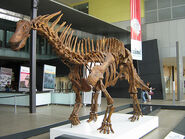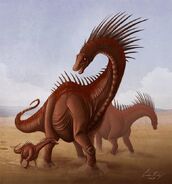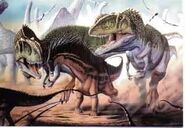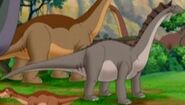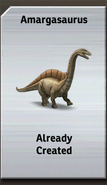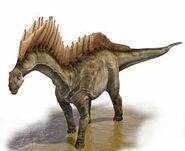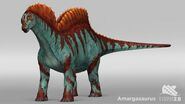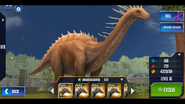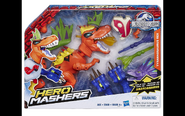Amargasaurus was a Diplodocoid which lived in the Early Cretaceous.It was small for a sauropod, reaching 10 meters (33 feet) length. It would have been a quadrupedal herbivore with a long, low skull on the end of a long neck. However, this dinosaur sported two parallel rows of tall spines down its neck and back, taller than in any other known sauropod. These spines have been reconstructed supporting skin sails, but the "skin sail" hypothesis was rejected by Gregory S. Paul in 2000.
Description
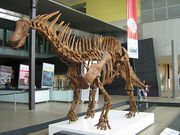
Amargasaurus skeleton, and the longspines of its neck
Amargasaurus was small for a sauropod, measuring 9 to 10 meters in length and weighing approximately 2,6 tones. The neck of Amargasaurus, measuring 2.4 meters in length, was proportionally short for sauropod standards.The trunk was made out of 9 dorsal and probably 5 fused sacral vertebrae.While the foremost dorsals were opisthocoelous, the remaining dorsals were amphyplatyan (flat on both ends).The most obvious feature of the Amargasaurus' skeleton were the extremely tall, upwardly projecting neural spines on the neck and foremost back vertebrae. The neural spines were bifurcated along their entire length, forming a double row. They were circular in cross section and tapered towards their tips. The tallest spines could be found on the middle part of the neck, where they reached 60 cm on the 8th cervical. On the neck, they were bowed backwards, projecting above the adjacent vertebra. Greatly elongated spines continue along the last two dorsal vertebrae, the hip and foremost tail. However, in these regions the spines were not bifurcated but flared into a paddle-shaped upper end.The skull is only incompletely preserved––however, it likely had a horselike, broad snout equipped with pencil-like teeth, based on related sauropods for which more complete skulls are known. As in other dicraeosaurids, the external nares (nostril openings) were situated in the posterior half of the skull, diagonally above the eye sockets, which were proportionally large.
Paleobiology
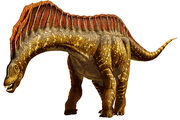
Amaragasaurus' sail, a expanded theory
The spines may have supported a pair of tall skin sails. Similar sails are seen in the unrelated dinosaurs Spinosaurus and Ouranosaurus, as well as the pelycosaurs Dimetrodon and Edaphosaurus. There are a variety of hypotheses for the function of these such sails, including defense, communication (for mating purposes or for simple species recognition), or temperature regulation.Gregory Paul argued that parallel neck sails would have reduced neck flexion. Instead, he proposed that, with their circular rather than flat cross-sections, these spines were more likely covered with a horny sheath. Similar spines are found on the presacral vertebrae of Dicraeosaurus from Africa, although not nearly as tall.
In Popular Culture
- In Pokemon series, there is an evolution family including Amura and Aurorus. They both resemble Amargasaurus.
- It was planned to be in Disney's Dinosaur, but was cut for unknown reasons.
- In Fossil Fighters Frontier, Amargo is one of the new vivosaurs in the game.
- Several are seen as background characters in The Land Before Time X: The Great Longneck Migration.
- It appears in Dinosaur Train.
- It appears briefly in Bizarre Dinosaurs where they talk about its' sails.
- It appears in Dinosaur King.
- It appears in Jurassic Park: Builder where it has only one sail, unlike in real life, which it had two sails.
- It appears in Dino Dan: Trek's Adventures where it is shown to have the ability to wiggle its' sails.
- It appears in Jurassic World: The Game where it has an accurate design in most of the forms.
- It appears in Jurassic World: Alive where it has an accurate design.
- Amargasaurus was originally supposed to appear in the movie Disney Dinosaur but was cut and it's concept art is shown. The concept art shows the inaccurate Amargasaurus had a club tail.
Gallery
Amargasaurus/Gallery

